The Capture of U-505 Helped America Crack the Kriegsmarine’s Ultra-Secretive Code
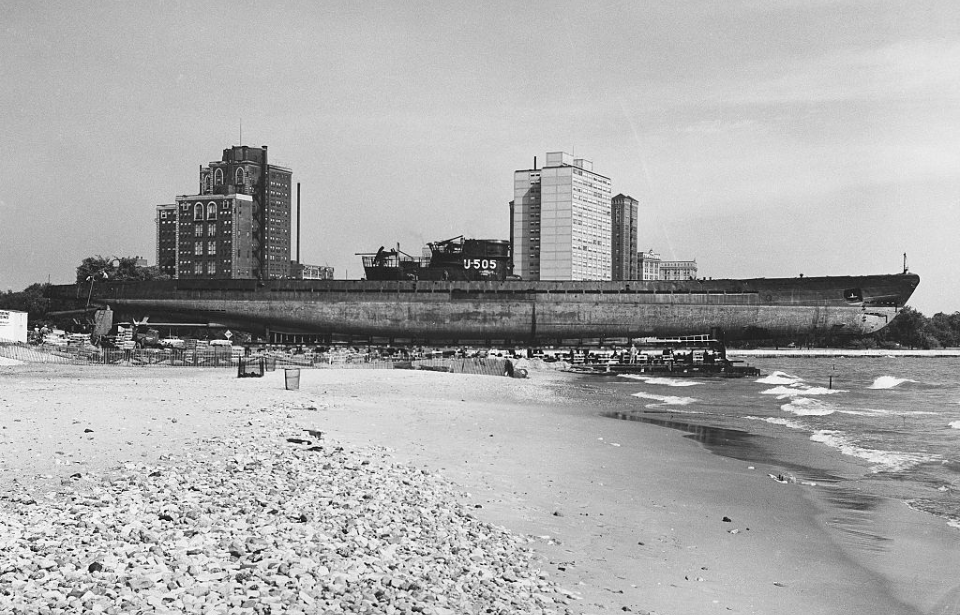
The capture of U-505 by the US Navy was one of the most secretive events of the Second World War. While on patrol off the coast of Africa, she was spotted by American vessels, who subsequently launched an attack and claimed the enemy U-boat as their own. Following the conflict, she was turned into a museum ship, which is open to the public.
Construction of U-505
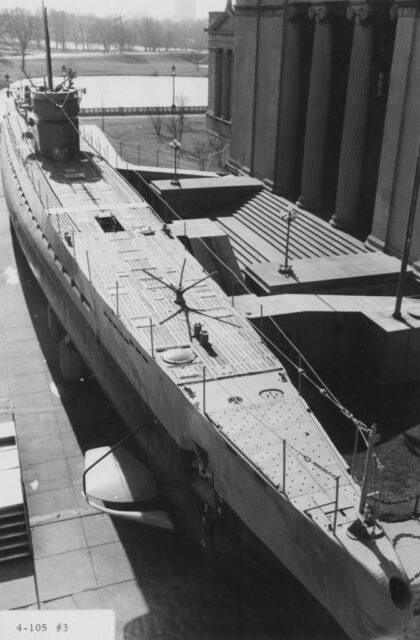
U-505 on display at the Museum of Science and Industry in Chicago, Illinois. (Photo Credit: Museum of Science and Industry, Chicago / Getty Images)
U-505 was a Type IXC U-boat that operated under the Kriegsmarine during the Second World War. Commissioned in August 1941, under the command of Kapitänleutnant Axel-Olaf Loewe, she was among the larger submarines in service to Germany.
The U-boat was powered by two shafts; two MAN M 9 V40/46 supercharged four-stroke, nine-cylinder diesel engines; and two Siemens-Schuckert 2 GU 345/34 double-acting electric motors, allowing her to reach a top speed of 8.4 MPH while submerged and 20.9 MPH when surfaced.
In terms of armaments, U-505 featured an array of ways to launch attacks and defend herself. She had six torpedo tubes – four at the bow and two at the stern – which fired 21-inch torpedoes, as well as a 10.5 cm SK C/32 naval gun. In terms of attacking Allied aircraft, the vessel was equipped with various anti-aircraft guns: one twin 2 cm FlaK 30 and a single 3.7 cm SK C/30.
Conducting 12 patrols throughout World War II
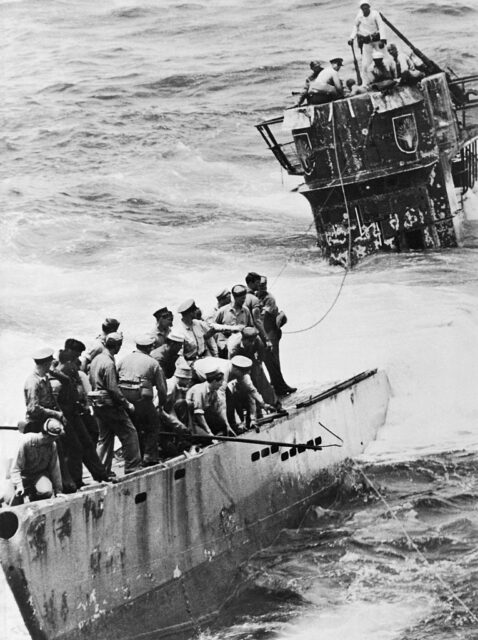
US Navy boarding party approaching U-505 after the call was made by her commander to abandon ship, 1944. (Photo Credit: Bettmann / Getty Images)
Throughout her wartime career, U-505 served under two flotillas – the 4th and 2nd U-boat – and four different commanders. She also conducted 12 patrols, sinking eight Allied ships: one Colombian, one Norwegian, one Dutch, two British and three American. While that number might make it seem like she was successful, the vessel exited the conflict with a reputation for being the “most heavily damaged U-boat to successfully return to port.”
U-505‘s first three patrols were rather eventless, except for the U-boat suffering minor damage during one attack. Her fourth time at sea proved more troublesome. While off the coast of Trinidad, the No. 53 Squadron RAF surprised the vessel, dropping a 250-pound bomb on her deck. Not only did this damage the pressure hull and anti-aircraft guns, but it also resulted in one death and one injured crewman.
The U-boat’s fifth patrol was similar to her first few, and her following four had to be aborted after just a few days at sea, given the vessel suffering equipment failure caused by Resistance members working at the French dockyards from which she was deployed.
Just when her crew thought things couldn’t possibly get worse, U-505‘s 10th patrol witnessed her commander, Kapitänleutnant Peter Zschech, take his own life. By comparison, her 11th deployment was smooth sailing. Her 12th would be her final patrol, as she’d be captured by the American forces.
U-505 is captured by Task Group 22.3 (TG 22.3)
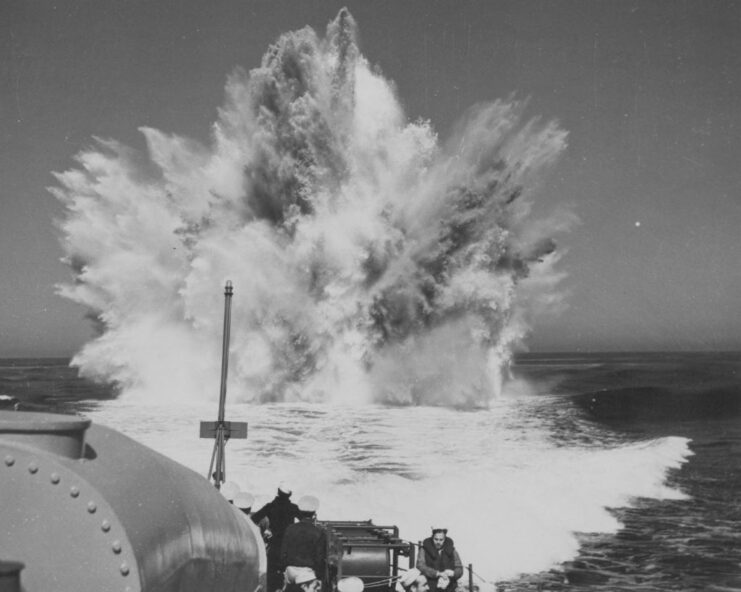
U-505 being depth charged during the US Navy’s attack on the U-boat, off the coast of Africa, 1944. (Photo Credit: Museum of Science and Industry, Chicago / Getty Images)
By mid-May 1944, the Allies had learned that German U-boats were operating off the coast of Cape Verde. As such, the US Navy made an effort to confront the enemy vessels. Task Group 22.3 (TG 22.3) – consisting of an escort carrier and destroyer escorts – was sent to the region, where, on June 4, they encountered U-505 approximately 105 miles from Río de Oro.
Looking to attack the U-boat, two Grumman F4F Wildcats and a TBM Avenger flew over the area to provide aerial support and reconnaissance. One of the destroyer escorts, the USS Chatelain (DE-149), fired her Hedgehog anti-submarine mortars, before deploying depth charges into the water. At the same time, the airborne aircraft fired their own weapons.
Badly damaged, U-505 eventually surfaced, opening the vessel up to additional fire from Chatelain, the two F4Fs and the other ships in TG 22.3. Aware of the severity of the situation, Oberluetnant zur See Harald Lange told his men to abandon ship. The typical course of action was to scuttle the U-boat in the process, but this wasn’t done correctly, leaving the vessel surfaced.
Boarding an enemy U-boat
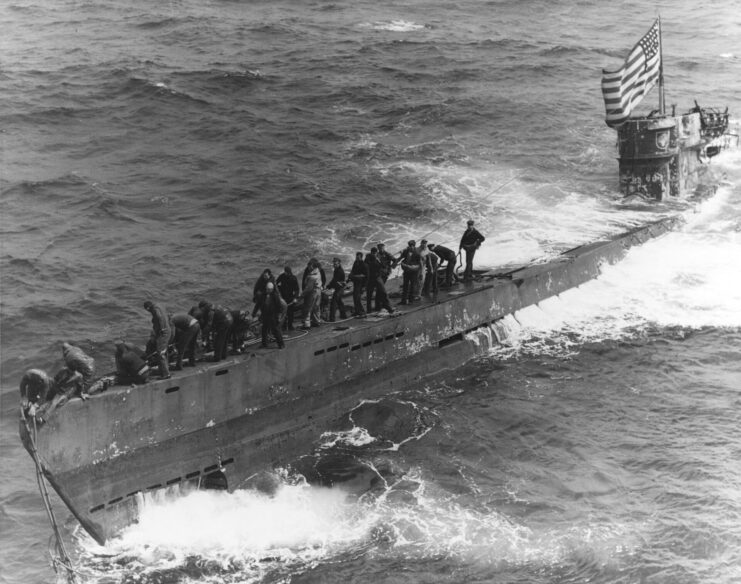
Boarding party from the USS Pillsbury (DE-133) securing a tow line to U-505 following her capture, 1944. She was eventually attached to the USS Guadalcanal (CVE-60), after issues arose. (Photo Credit: U.S. Navy / Wikimedia Commons / Public Domain)
With U-505 abandoned, Capt. Daniel V. Gallery, Jr. ordered the USS Jenks (DE-665) to pick up the survivors, while an eight-man boarding crew from the USS Pillsbury (DE-133) made their way to the U-boat. Once aboard, they collected codebooks and charts, and made efforts to keep water from filling the damaged vessel.
The former was of particular importance, as codes that had before been impossible to decipher could now be broken, saving not only Allied ships, but lives, as well. On top of this, their boarding marked the first time an enemy warship had been captured by the US Navy at-sea since the War of 1812.
Pillsbury initially attempted to tow U-505, but issues arose, leading the escort carrier USS Guadalcanal (CVE-60) to attach a tow line to the enemy vessel, before transferring the U-boat to the fleet tug USS Abnaki (ATF-96) three days later. While the logical next step would have been to travel with the submarine to Allied-controlled French Morocco, which was nearby, German spies in the protectorate meant another location needed to be selected.
Held captive by the US Navy
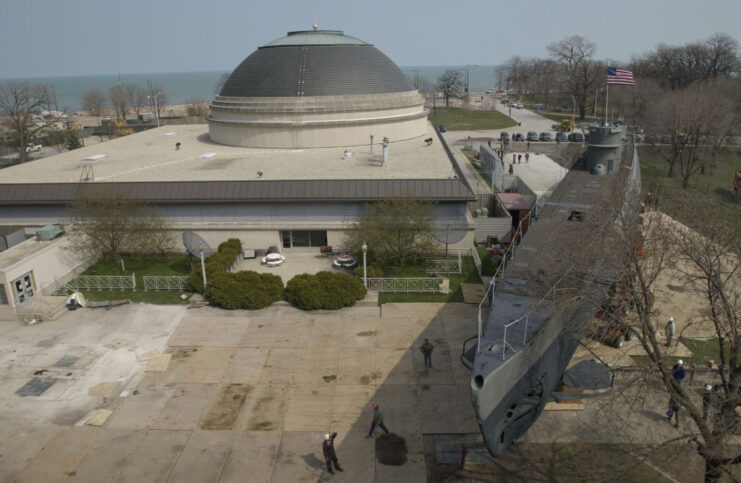
U-505 on display at her former position at the Museum of Science and Industry in Chicago, Illinois, 2003. She has since been relocated to a climate-controlled room, to prevent further deterioration caused by the elements. (Photo Credit: J.B. Spector / Museum of Science and Industry, Chicago / Getty Images)
Following U-505‘s capture, the U-boat was towed to the US Naval Operation Base in Bermuda, where her presence was kept a secret. The Americans feared that publicly acknowledging her capture would impact intelligence and code-breaking efforts, so only a select few were granted permission to examine the vessel and her codebooks.
To keep up the illusion that U-505 had been sunk, the U-boat was repainted and designated the USS Nemo.
An obvious concern regarding the secrecy surrounding the vessel was her crew. If they were released back to Germany or if it was let slip that they were still alive, then the story about U-505 sinking would immediately be proven false. As such, the 58 surviving crewmen were sent to Camp Ruston, a prisoner of war (POW) camp in Louisiana. To ensure no one knew they were still alive, the group was held in a separate area and denied supplies from the Red Cross.
Following the end of the war in Europe, U-505 was sent on a tour of the East Coast, to promote the sale of war bonds that would aid in the ongoing battle against Japan. Those who bought one were also given the option to purchase a ticket to tour the vessel.
Where is U-505 now?
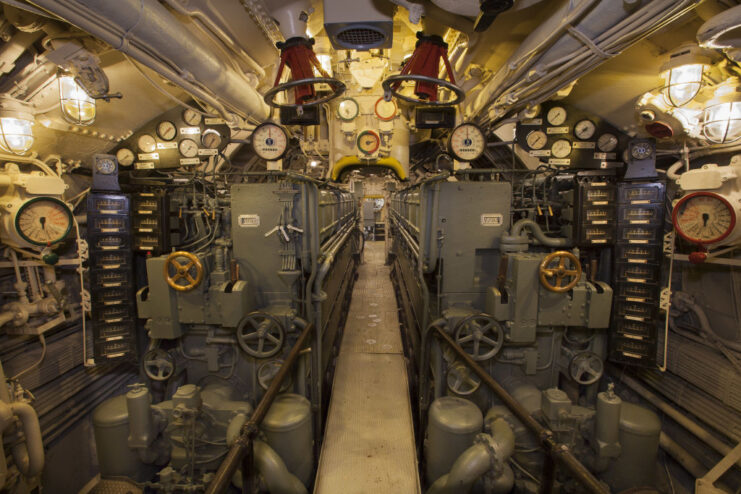
U-505‘s engine room, as seen at the Museum of Science and Industry in Chicago, Illinois, 2012. (Photo Credit: J.B. Spector / Museum of Science and Industry, Chicago / Getty Images)
Following Japan’s surrender, the US Navy saw no use for U-505 and, thus, decided to use the U-boat for target practice until she became too damaged to remain afloat. This plan didn’t sit right with Rear Adm. Daniel V. Gallery, Jr., who contacted his father. The elder Gallery, in turn, reached out to Lenox Lohr, the president of Chicago’s Museum of Science and Industry, who was more than happy to give the vessel a new home.
Nearly a decade later, in 1954, the United States government donated U-505 to the institution, with residents raising $250,000 for the U-boat’s transport and installation. Lohr also requested that German manufacturers craft replacement parts to stand in place of the ones that had been removed while the submarine was being held by the US Navy.
On September 24 of that year, the vessel was dedicated as a memorial to the sailors who’d lost their lives during the Atlantic Campaigns of World War I and II. In 1989, U-505 became a National Historic Landmark. Some 15 years later, the vessel was moved to a climate-controlled room, as the harsh Chicago weather had caused the exterior to begin to deteriorate.
More from us: Jimmy Buffett Anonymously Donated Two WWII-Era Aircraft to a Museum Before His Death
In 2019, U-505 underwent a complete refurbishment, with the work done restoring the U-boat closer to her original state.





